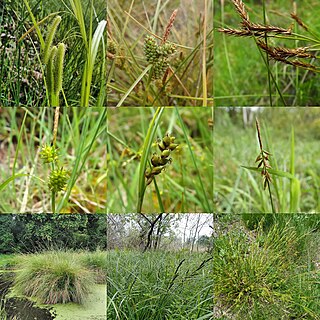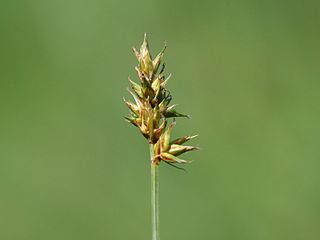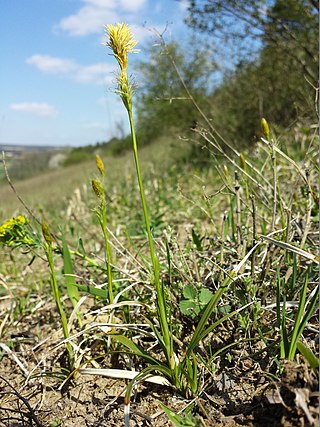
The Cyperaceae are a family of graminoid (grass-like), monocotyledonous flowering plants known as sedges. The family is large; botanists have described some 5,500 known species in about 90 genera – the largest being the "true sedges", with over 2,000 species.

Ornamental grasses are grasses grown as ornamental plants. Ornamental grasses are popular in many colder hardiness zones for their resilience to cold temperatures and aesthetic value throughout fall and winter seasons.

Carex is a vast genus of over 2,000 species of grass-like plants in the family Cyperaceae, commonly known as sedges. Other members of the family Cyperaceae are also called sedges, however those of genus Carex may be called true sedges, and it is the most species-rich genus in the family. The study of Carex is known as caricology.

Carex archeri, known as Archer's sedge, is a species of sedge in the genus Carex, endemic to south-eastern Australia.

Carex morrowii, the kan suge, Morrow's sedge, Japanese grass sedge or Japanese sedge, is a species of flowering plant in the family Cyperaceae. It is native to central and southern Japan, and has been introduced to Belgium, Denmark and Austria.
Carex tereticaulis, also known as basket sedge, is a species of sedge of the family Cyperaceae that is native to southern parts of Western Australia, southern parts of South Australia, southern and eastern parts of New South Wales as well as north western and central Victoria and Tasmania. The Koori peoples know the plant as Poong'ort.
Carex ligulata is a species of flowering plant in the sedge family, Cyperaceae. Carex ligulata is native to Asia from India to Japan. It grows in a variety of habitats, including grasslands, forests, mountain slopes, and riparian areas.

Carex remota, the remote sedge, is a species in the genus Carex, native to Europe, the Atlas Mountains in Africa, and western Asia. It is a riparian forest specialist. It is known as one of the most frequently hybridizing species of Carex, forming hybrids with C. appropinquata, C. arenaria, C. brizoides, C. canescens, C. divulsa, C. echinata, C. elongata, C. leporina, C. otrubae, C. paniculata, and C. spicata.
Carex tasmanica, called curly sedge, is a species of flowering plant in the family Cyperaceae, native to Victoria and Tasmania states in Australia. It gets its common name from the distinctive helical spirals its leaves form when they dry out. Considered a threatened species, none of its populations are in a protected area.

Carex fuliginosa, the short-leaved sedge, is a species of flowering plant in the family Cyperaceae, with a circumpolar distribution, and found in mountains further south; such as the eastern Alps, the Carpathians and the Rockies. It is wind-pollinated.

Carex pairae is a species of perennial grass in the family Cyperaceae (sedges). They have a self-supporting growth form and simple, broad leaves. Individuals can grow to 0.21 m tall.

Carex michelii is a species of sedge, native to central, southern and eastern Europe, Turkey, the Caucasus, and Iran. It is typically found in semi‑arid grasslands.
Carex chlorosaccus is a species of sedge in the family Cyperaceae, native to the Gulf of Guinea islands, southwestern Cameroon, and central and eastern tropical Africa. It is typically found in upland grasslands and the understories of montane forests.

Carex retrorsa, the knotsheath sedge, deflexed bottlebrush sedge, or retrorse sedge, is a widespread species of flowering plant in the family Cyperaceae, native to southern Canada and the northern United States. Preferring wet areas and tolerant of some shade, it is available from speciality nurseries for such uses as ecological restoration projects, erosion control, and rain gardens.
Carex baltzellii, Baltzell's sedge, is a species of flowering plant in the family Cyperaceae, native to the US states of Mississippi, Alabama, Florida, and Georgia. A rare species, it is found only on the slopes of forested ravines.
Carex peregrina is a species of sedge, with a remarkably disjunct distribution; it is found in the Azores and Madeira islands in the eastern Atlantic, and more than 6,000 km (3,700 mi) away in the mountains of Ethiopia, Kenya, Uganda and Tanzania, in east Africa. It prefers to grow in montane forests but occasionally is found sunny grasslands from 2,300 to 3,500 m above sea level.
Carex xerantica, the dry sedge, dryland sedge, or white-scaled sedge, is a species of flowering plant in the family Cyperaceae, native to western and central Canada, and the north-central United States. It can be found in a wide variety of habitats, including meadows, prairies, open woodlands, bluffs, sandy or rocky areas, and even talus slopes.
Carex cephalotes, also known as wire-head sedge, is a tussock-forming species of perennial sedge in the family Cyperaceae. It is native to south eastern Australia and New Zealand.
Carex polyantha, commonly known as river sedge, is a tussock-forming species of perennial sedge in the family Cyperaceae. It is native to eastern parts of Australia.

Carex healyi, the harsh-leaved bastard grass, is a species of flowering plant in the family Cyperaceae, native to New Zealand. Found in a wide variety of habitats but preferring semi-shade, its chromosome number is 2n = 88.












